phenomenology - The branch of philosophy that studies all possible appearances in human experience (phenomena), during which considerations of objective reality and of purely subjective response are left out of account.
Also see empiricism, epistemology, interdisciplinary, metaphysics, ontology, science and art, and teleology.
phenomenon - An occurrence, a circumstance, or a fact that is perceptible by the senses. The plural form is phenomena.
Also see light, moiré, and sight.
phiale - In ancient Greece, and other ancient Mediterranean cultures, a bowl or wide cup without a handle, traditionally used for libations: ritual offerings of wine or olive oil to the gods — ceremonies in which the liquid would be spilled over an altar or a burial site to satisfy the souls of the deceased. At their center, a phiale is likely to have an omphalos, the mythic navel of the universe. Phiales are typically metal, although they were sometimes produced in clay or glass.
(pr. FI-ə-lee)
Example:

Hellenistic, Phiale, c. 300 BCE, repoussé gold, diameter 23 cm, Metropolitan Museum of Art, NY. A radial pattern of acorns and bees, each symbolizing the earth's "victual in plenty," as described by Hesiod. In the center is a large boss representing the omphalos. See Hellenistic art.
philluminist - One who collects matchbooks or matchbox tops.
Example matchbooks:
![]()

![]()
American, Coca-Cola matchbooks, c. 1940-1995.
Art about matchbooks:

Molly Springfield (American, 1977-), Matchbooks,
2001, oil on paper,
29 x 5.5 inches, collection of the artist. Many painters of trompe l'oeil
have chosen ephemera as their subject matter. Molly Springfield
is a contemporary example.Her
web site may present other such works.
Also see deltiologist, ephemera, exonumia, numismatics, philately, printing, and scripophily.
![]()

![]()
philtrum - In the anatomy of the human face, the area below the septum of the nose down to the upper lip. The philtrum is comprised of a pair of vertical ridges (also called the philtral columns) separated by a vertical groove (also called the philtral dimple).
Also see ala and alar groove, bust, portrait, and self-portrait.
phosphene - A sensation of light caused by excitation of the retina by mechanical or electric means rather than by light, as when the eyeballs are rubbed through closed lids.
photoCD - A storage method for digital images. In the basic Kodak PhotoCD configuration, five different levels of image quality are stored for each image in an Imagepac (a file-storage format.)
photocopy - To make a photographic
reproduction of printed or graphic material, 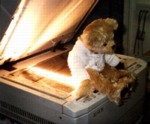 especially
by xerography. This is the
most common contemporary method
of making inexpensive photo images
on paper. Photocopy machines are commonly
sited in schools, libraries, businesses, etc. Also, a piece of
such photographic or xerographic reproduction. Other photographic
means of reproduction include blueprinting, facsimile,
microfilming, and photostats.
especially
by xerography. This is the
most common contemporary method
of making inexpensive photo images
on paper. Photocopy machines are commonly
sited in schools, libraries, businesses, etc. Also, a piece of
such photographic or xerographic reproduction. Other photographic
means of reproduction include blueprinting, facsimile,
microfilming, and photostats. We are S H O C K E D . S H O C K E D : a Teddy Bear caught in the act of mooning a
photocopier.
photogene - See afterimage.
photogram - A photographic print made by placing an arrangement of objects on photosensitive paper exposed to light to yield an image of ghostly silhouettes floating in a void of darkened space. The first photogram was probably made around 1802.
Examples:
![]()
Anna Atkins (English, 1799-1871) and Anne
Dixon (English, 19th century), Equisetum sylvaticum, 1853, cyanotype
photogram,10 x 7 7/8 inches, J. Paul Getty Museum, Malibu, CA.
Anna Atkins produced the first photographically illustrated book,
British Algae: Cyanotype Impressions, in 1843. She included
this photo in her second book, Cyanotypes of British and Foreign
Ferns, c. 1860.

William Henry Fox Talbot (British, 1800-1877),
Wrack, 1839, salted paper print, 22 x
17.5 cm (8 11/16 x 6 7/8 inches), Metropolitan Museum of Art,
NY.

Hippolyte Bayard (French, 1801-1887), Arrangement of Specimens, Paris, about
1842, direct positive print (cyanotype
photogram), 10 15/16 x 8 1/2 inches (27.7 x 21.6 cm), J. Paul
Getty Museum, Malibu, CA.
Man Ray (born Emmanuel Rudnitzky) (American, 1890-1976)

László Moholy-Nagy (born Hungary, active in Germany and the USA, 1895-1946), Untitled (Positive), c. 1922-1924, gelatin
silver print from photogram negative,
.237 x .178 m (9 5/16 x 7 inches), National Gallery of Art, Washington
D.C. See Bauhaus,
German art, Hungarian
art, and positive.

László Moholy-Nagy, Hand Photogram, c. 1925, gelatin silver print photogram, 9 3/8 x 7 inches (23.81 x 17.78 cm), Los Angeles County Museum of Art.

Adam Füss (British, 1961-), Now!, 1988, gelatin silver print, 169.5
x 129.5 cm (66 3/4 x 51 inches), Metropolitan Museum of Art,
NY.
Also see positive and rayograph.
photograph and photo - See photography.
photographic - Having to do with photography. Often referring to an image's resemblence to a photograph — similar to the way it's subject would appear in a photograph, with great accuracy and fidelity of detail.
photogravure - A photomechanical printmaking process invented in 1879. A photographic image is transfered to a copper plate which is chemically etched. The plate is hand-inked for each print.
Examples:
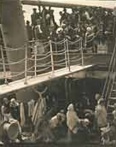
Alfred Stieglitz (American, 1864-1946), The Steerage, 1907, photogravure, published
in 1915 as a special supplement to No. 7-8 of Camera Work;
13 1/8 x 10 3/8 inches (33.3 x 26.4 cm), Minneapolis Institute
of Art. See Photo-Secession.

Karl Blossfeldt (German, 1865-1932),
Delphinium, from the album "Urformen der Kunst," 1928, photogravure, 10 x 7 1/2 inches (25.4 x 19.05 cm), Los Angeles County Museum of Art.

Edward Sheriff Curtis (American, 1868-1954), A Hopi Man, 1921, photogravure on vellum paper, 15 1/8 x 11 3/8 inches (38.42 x 28.89 cm), Los Angeles County Museum of Art.
Related link:
 Inc, and the Library
of Congress. On its Illustrated Book Study Resolution Samples pages, visitors can examine digital images of prints of several
types — collotype, copper
engraving,
etching, halftone, lithograph, mezzotint,
photogravure, steel engraving,
and wood engraving — at
each of several resolutions — dots per inch (DPI).
Inc, and the Library
of Congress. On its Illustrated Book Study Resolution Samples pages, visitors can examine digital images of prints of several
types — collotype, copper
engraving,
etching, halftone, lithograph, mezzotint,
photogravure, steel engraving,
and wood engraving — at
each of several resolutions — dots per inch (DPI).
Also see photography and positive.
photomechanical graphic - Photographic (and analog) processes used in preparing to print images with the printing plates. Color separation is one of the functions of photomechanical processes — making a separate printing plate for each of the color components in a color picture. Usually there are four: one plate for yellow, one for blue (cyan), one for red (magenta), and one for black. Images printed by offset lithography — the printing process by which the majority of periodicals are printed for example — have invariably been photomechanical graphics until computer graphic processes have gotten to take over some of this territory. A computer generated image is more likely to be called a computer graphic or digital graphic.
Also see moiré.
photomontage - A montage of photographs.
(pr. FOH-toh-mən-TAHZH)
Examples:
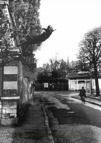
Yves Klein (French, 1928-1962), Leap into
the Void, 1960, photomontage, silver gelatin print, 350 x
270 mm. This photograph shows
Klein falling from a wall toward the pavement of a Parisian street.
Producing the picture at the time of the first human
travels beyond earth's atmosphere, Klein was alluding to the
human bodys' altered relationship to the cosmos. See void.

David Hockney (English, lives and works in
USA, 1937-), Portrait
of the Artist's Mother, c. 1985?, photocollage. This
is called a photocollage rather than a photomontage, because
it is more three-dimensional
than a montage tends to be. Hockney reflected extensively on
his process of collaging prints taken with a 35 mm camera as connecting to the Cubist sense of multiple
angles and especially of
movement.
These "multiples" (as he called them) convey a strong
sense of movement, Hockney argued, in that the viewer must keep
readjusting his imagined viewpoint as his gaze travels from print
to print. And of course by this means the viewer builds up a
single image that is many times wider in angle of view than the
camera lens. (The viewing
angle of a standard 55mm lens for a 35mm format camera is about
45 degrees. Wide angle lenses increase the angle of view to about
75 degrees without obvious distortion, but the human angle of
view, with eye movement, is about 180 degrees.)This portrait
of Hockney's mother illustrates the technique
at close range. See collage.
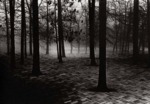
Scott Mutter (American, 1944-), Untitled (Forest), 1975, gelatine-silver
print photomontage, 11 x 14 inches, American Museum of Photography. This forest
has a parquet floor. "While
others use the techniques of photomontage for shock effect, Mutter
creates worlds that can best be described as 'hyper-realistic.'
" See incongruity.

Tim Hawkinson (American, 1960-), Untitled, 2003, photomontage of unique digital photographs on foamcore on panel, 68 x 117 inches, collection of Martin and Rebecca Eisenberg. Hawkinson has used his own body as the subject of an image comparable to a fractal. See body art.
Related link:
Also see appropriation, bricolage, collage, coulage, culture jamming, découpage, detournement, femmage, frottage, fumage, incongruity, montage, parsemage, and pasteup.
photon - A subatomic particle having zero mass, no electric charge, and an indefinitely long lifetime. Photon is also the name of a unit of retinal illumination, equal to the amount of light that reaches the retina through one square millimeter of pupil area from a surface having a brightness of one candela per square meter.
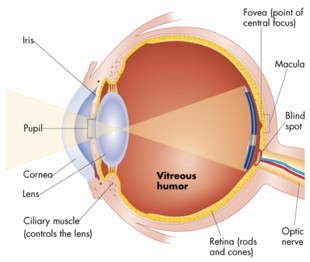
photoreceptors - Anatomically essential to seeing, photoreceptors are the nerve
endings (brain cells called neurons) sensitive to light,
that line the retina, located
on the surface of the inner eyeball opposite the eye's lens. Here
millions of photoreceptors are differentiated into the neurons
called rods and cones,
which are connected by  the optic nerve to the brain.
the optic nerve to the brain. In this illustration, the rods and cones are
the pink forms shown embedded in the anterior of the retina's
surface. The more uniformly thin rods,
among the more thickly formed cones.
Also see afterimage, binocular vision, colorblind, cross-section, gestalt, night blindness or nyctalopia, Op Art, ophthalmology, optical, optical mixing, perception, and peripheral vision.
Photo-Secession or Photo Secession - An American photography movement from 1905-1917. It was led by Alfred Stieglitz, whose Little Galleries of the Photo-Secession later became Gallery 291 (from its address at 291 Fifth Avenue, New York, NY). Steiglitz edited the journal Camera Work during these years, publishing it from the 291 Gallery.
Examples of Photo-Secession works:

Alfred Stieglitz (American, 1864-1946), The Steerage, 1907, photogravure,
published in 1915 as a special supplement to No. 7-8 of Camera
Work; 13 1/8 x 10 3/8 inches (33.3 x 26.4 cm).

Alfred Stieglitz, Georgia O'Keeffe, 1918, platinum print,
11.7 x 9 cm (4 5/8 x 3 9/16 inches), Metropolitan Museum of Art,
NY. Painter Georgia O'Keeffe (American, 1887-1986) was married
to Stieglitz. See feminism and feminist
art.

Alfred Stieglitz, Georgia O'Keeffe, 1921, palladium print,
23.6 x 19.2 cm (9 5/16 x 7 9/16 inches), Metropolitan Museum
of Art, NY.

Alice Boughton (American, 1865-1943), Untitled
(Head of a Woman with Tousled Hair), glycerine-developed
platinum print, c. 1905, American Museum of Photography.

Edward Steichen (American, born Luxembourg,
1879-1973), The Flatiron, 1904, printed 1909, depicted:
New York City, New York, United States of America, gum bichromate
over platinum print, 47.8 x 38.4 cm (18 13/16 x 15 1/8 inches),
Metropolitan Museum of Art, NY.
Edward Steichen, Balzac, The Silhouette - 4 A.M., 1908, depicted: Meudon, France, gum bichromate print, 37.9 x 46 cm (14 15/16 x 18 1/8 inches), Metropolitan Museum of Art, NY.

Imogen Cunningham (American, 1883-1976), Alfred Stieglitz in American Place, 1934, gelatin silver print, 24.1 x 19.0 cm, George Eastman House, Rochester, NY. American Place was Stieglitz's gallery in later years.
See secession.
Photoshop - A sophisticated software program, produced by Adobe Systems, for altering and processing digital photographs and other digital images.
Also see GraphicConverter.
photoscreen - A technique employing photographic processes to create stencil screens from graphic images, which then become part of complex printing or painting processes.
Also see silkscreen.
 pi - The sixteenth letter of the Greek alphabet,
which in mathematics stands for
a transcendental number, approximately 3.14, which expresses the
ratio of the circumference
to the diameter of a circle
and appears as a constant in many mathematical expressions. If
you need it carried a few places further to the right [quite unlikely
actually, but just in case, here are 52]:
pi - The sixteenth letter of the Greek alphabet,
which in mathematics stands for
a transcendental number, approximately 3.14, which expresses the
ratio of the circumference
to the diameter of a circle
and appears as a constant in many mathematical expressions. If
you need it carried a few places further to the right [quite unlikely
actually, but just in case, here are 52]:
pi = 3.14159265358979323846264338327950288419716939937511
2 pi = 6.283185306
Pi squared = 9.86960440108935861883
The square root of pi = 1.772453851
In China, pi is a bee which symbolizes heaven; a jade disk.
piano nobile - In Renaissance architecture, the principal story, usually the second (the floor just above [what in America is known as] the first or ground floor).
pica - In typography, a unit of measurement in which there are 12 points to a pica and 6 picas to an inch.
picassiette - See pique assiette.

pick - A tool consisting of a curved iron bar with a point at one end and a chisel edge at the other, fitted to a long handle, and used to quarry, mine and break stones, and also to shape them in the most basic way.
pickle - An acid solution
in which to soak metals either
to clean
them or to achieve an artificial
patina. Many metals, including
bronze and silver,
when newly cast are covered
with oxides which are easily
removed by pickling.
PICT - Macintosh Picture. A storage format for digital images designed primarily for Macintosh computers. Other digital image file formats include GIF (Graphic Image File), JFIF, JPEG (Joint Photographic Experts Group), AI (Adobe PhotoShop), APS (Adobe PhotoShop), PICT (Macintosh Picture), and TIFF.
Also see Adobe, GraphicConverter, and Photoshop.
pictogram - See pictograph.
pictograph - Also called a pictogram, figurative drawing or picture representing a word, sound or idea. Earliest form in the evolution of a system of writing. An example is the ancient Egyptian writing called hieroglyphs. This method of communication is still used today by certain civilisations including Chinese, Japanese, and American Indians. It may also refer to a pictorial representation of numerical data or relationships, especially a graph, but having each value represented by a proportional number of pictures.
Example:
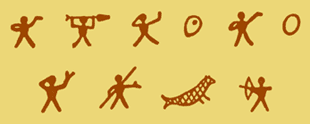
In this series of pictographs the message
is "I go with boat to that island. I sleep there, then go
to another island. I sleep there twice. (Two nights.) I hunt
and catch one sea lion."
Other resources on pictographs:
Also see font, glyph, heraldry, hieroglyphics, icon, iconomatic, ideogram, lettering, logo, petroglyph, text, type, typeface, and typography.
picture - A visual representation or image drawn, painted, photographed, or otherwise produced on a flat surface. Considered as a synonym for painting, some Americans mistakenly think it uncultivated, however the term is much more commonly used by the British.
Quote:
Also see print, rebus, sketch, and study.
picture plane - In perspective, the plane (a flat level) occupied by the surface of the picture — its frontal boundary. When there is any illusion of depth in the picture, the picture plane is similar to a plate of glass behind which pictorial elements are arranged in depth. Artists indicate the supposed distance of subjects beyond the picture plane through the use of changes in the sizes of things, the ways they overlap each other, and (when subjects are placed on the depicted ground, as opposed to flying above it) by positioning them on the area taken up by the depicted floor, ground, or a body of water. Abstract Expressionists worked directly on the plane itself, unconcerned with recession in depth.
picturesque - In general, this may refer to any scene which seems to be especially suitable for representation in a picture, especially that which is sublime. It is especially associated with an aesthetic mode formulated in the late eighteenth century which valued deliberate rusticity, irregularities of design, and even a cultivated pursuit of quaint or nostalgic forms. Such pictures became common in nineteenth century Europe and America. Examples can be found among the American painters of the Hudson River school — Thomas Cole (1801-1848), Jasper Cropsey (1823-1900), and Asher B. Durand (1796-1886) — and of the Rocky Mountain school — Albert Bierstadt (1830-1902) and Thomas Moran (1837-1926).
Examples:
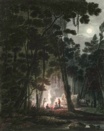
John Hill (American engraver, 1770-1850), View by Moonlight, Near Fayetteville, after a painting by Joshua Shaw (American, 1776-1860), published in Picturesque Views of American Scenery by M. Carey & Son, 1820, hand-colored engraving, New York Public Library. Several figures stand around a campfire in a forest. It is unclear whether this is near Fayetteville, Arkansas or Fayetteville, North Carolina. See nocturne.
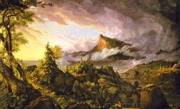
Thomas Cole (American, 1801-1848), The
Course Of Empire: Savage State, no date, oil on canvas,
39 1/4 x 63 1/4 inches, New-York Historical Society. See landscape,
Luminism, and Romanticism.
Quote:
Also see bad art, calendar painting, chinoiserie, kitsch, landscape, low art, paint-by-number, pastoral, rustic, sacral-idyllic scene, and seascape.
piebald - Patchy or spotted, especially in black and white, or, less frequently, other colors. Piebald is often used in describing horses, dogs, and other animals.
(pr. PI:-bawld)
Example:
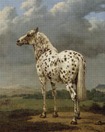
Paulus Potter (Dutch, c. 1650-1654), The Piebald Horse, oil
on canvas, 19.5 x 17 11/16
inches, J. Paul Getty Art Museum, Malibu, CA. See equine
and equestrian art.
Also see ablaq, brindled, maculate, pattern, punctate, and variegated.
piece - To join parts to form a whole. When the whole is a sculpture, the parts are often projecting extremities or accessories, especially in marble sculpture. "Piece" sometimes refers to an artifact, an artwork, or an object, or to a part of one. Also see masterpiece.
piece mold - A mold made in interlocking sections which can be used in making several casts since the mold is easily removed each time without being damaged. Piece molds are most often made of plaster, but might also be made of clay. Also see drape mold.
pie chart - See graph.
pied de biche - A claw chisel with two long points. This is the French name (literally "deer's foot") for what in Italy is called a calcagnolo.
(pr. pee-ay' deh beesh)
Also see bush hammer.
pier - A sculptural and an architectural term with several possible meanings. It is most commonly a platform extending from a shore over water and supported by piles or pillars, used either as a mooring for ships or boats, or for entertainments of other sorts. And finally, it may be any of several sorts of vertical supporting structures: such as a massive vertical pillar (rectangular, round, or compound in cross-section), a buttress; a section of wall that is used to support an arch, vault, or other kind of roof, or, a supporting structure at the junction of connecting spans of a bridge.
(pr. peer)
Related link:
Also see column, fenestration, and socle.
 pigment
- Finely powdered color material
which produces the color of any medium.
Made either from natural substances or synthetically,
pigment becomes paint, ink, or dye
when mixed with oil, water
or another fluid (also called vehicle).
When pressed into wax it becomes
a crayon, pencil
or chalk.
pigment
- Finely powdered color material
which produces the color of any medium.
Made either from natural substances or synthetically,
pigment becomes paint, ink, or dye
when mixed with oil, water
or another fluid (also called vehicle).
When pressed into wax it becomes
a crayon, pencil
or chalk.
An image of making and using pigments:
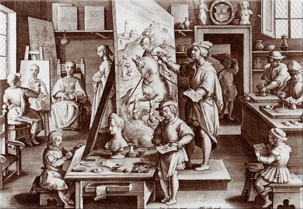
Jan van der Straet (also known as Stradanus)
(Dutch, 1523-1604), Painter's Studio, woodcut. As the master
paints a large canvas
with a picture of St. George
and the Dragon at the center, an apprentice
paints a portrait from a model at left, two make drawings and one mixes colors in the foreground,
two more grind pigments into
oil on the right, and a last
one carries a canvas toward the doorway. Windows let in natural
light from several angles. There are numerous shelves, drawers
and tables for supplies and works-in-progress. See studio.
Related resources:
Also see alizarin, antimony, azurite, binder, brown, cadmiums, chrome yellow, cerulean blue, chroma, cobalt, colorant, color wheel, copper resinate, Egyptian blue, emerald green, encaustic, feather, fluorescent colors, fugitive, green earth, grind, Indian red, Indian yellow, indigo, intarsia, jewelry, lead tin yellow, lemon yellow, madder lake, malachite, Material Safety Data Sheet (MSDS), mortar and pestle, Naples yellow, ochres, orange, orpiment, permanent, Prussian blue, purple, realgar, sepia, siena, smalt, stain, triturate, ultramarine, umber, verdigris, vermilion, viridian, white lead, yellow, and zinc white.
pigment printing - A photographic printing method, in which a halftone picture results from pigments embedded in gelatin. The primary material is a paper called "pigment paper", a paper coated with a mixture of gelatin and pigment. The paper is made light-resistant through a bath in chromcarbonate solution, then it is dried and photoprocessed with a halftone negative. Visit Manfred Rupp's site for Hans Ulrich's more thorough description of this process. He claims that pigment printing is the best photoprocess for color, tone and lightfastness known to date; indeed that it is the only color photopositive process that has its longevity, in contrast to the standard processes which hold their colorfastness and light-resistance no more than twenty years.
pilaster - ![]() In architecture,
a flat, rectangular
column (often fluted)
with a capital and
base, attached to or set into
a wall as an ornamental motif. It may be decorative
or used to buttress the wall.
In architecture,
a flat, rectangular
column (often fluted)
with a capital and
base, attached to or set into
a wall as an ornamental motif. It may be decorative
or used to buttress the wall.
![]()
(pr. pil-LAS-tər)
Examples:
Eight types of pilasters observed in the Blair Plain.
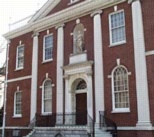
William Thornton (American, 1759-1828), Library Company, 1791, Philadelphia. The façade of this red brick Georgian or Federal style building bears four white pilasters. They rise from the level of the "water table" (even with the top of the entry stairs) to the bottom of the pediment, which crowns the building. Thornton is most reknowned as the original architect of the US Capitol.
Related link:
The Glossary of Medieval Art and Architecture defines pilaster and provides an illustration.
Also see Corinthian, Doric, order, pier, and respond.
pilotis - In architecture, thin steel or reinforced concrete posts used by architects in the early twentieth century to support concrete roof and floor slabs, avoiding the need for bearing walls.
(pr. pee-LOH-teez)
The singular form is piloti.
pillar - Usually a weight carrying member, such as a column or a pier. Sometimes it is an isolated, freestanding structure used for commemorative purposes.
In Japanese art tradition, a pillar print is a narrow vertical print, known as hasira-e.
Also see menhir, monolith, monument, pilaster, portal, post, respond, and support.
https://inform.quest/_art